Marlene Bart has always been curious, so coming to work in the Venetian Lagoon during a worldwide pandemic was an opportunity she wasn’t going to miss. The German artist, who lives and works in Weimar and Berlin, is the latest to work in Berengo Studio thanks to a residency run in collaboration with Venice’s Fondazione Tedesco (Centre for German Studies). During a spare moment Bart took the time to sit down and talk about her artistic practice, and her experience working in the studio.
So when did your fascination with the natural world begin?
I was reflecting on these books from my childhood: eyewitness books and encyclopaedias for children. I realised that I was still fascinated by how knowledge is transmitted through images, how pages work, what happens if you put certain images or objects in connection to each other, or what it means if one thing is bigger or smaller than the other. So I did a lot of research about encyclopaedias, and mostly those that focus on natural history or anatomy. I did a lot of research, collecting more than 4000 images that I’m still using to create new ideas. So I do collages out of a lot of elements, and these things can end up informing my printmaking, which is actually more of my background. So I’m a printmaker. I do a lot of screen printing and etching, but at some point, I wanted to do something three dimensional. So then I got into working with epoxy, and then also porcelain and bronze, so glass feels like another extension of that.
When did you first take the leap from working with two dimensional to three dimensional?
It wasn’t a conscious decision, I just tried it. When I did this research into encyclopedias, I also found out about the phenomenon of cabinets of curiosities. So for me, this was like a spatial version of the encyclopedia. I didn’t just want to think about the book, I wanted to think about the objects that ended up in the book, so my artistic research focuses a lot on the phenomenon of cabinets of curiosities which were once a huge trend – especially among the rich – who started collecting absurd things that they could show to prove their power and their knowledge. I was interested in what objects can come together in these cabinets, and contemporary equivalents. So I went to a lot of Institutes and Collections, like an institute that was researching the genetic material of mushrooms, but also like a collection for microorganisms and at the same time trying to see the supermarket as a contemporary cabinet of curiosities. I’m always trying to reflect on our idea of what a curiosity is somehow?
The move from two dimensions to three also means you have to consider an audience…
Yes it’s a different kind of interaction. I enjoy building a whole space with everything, designing my own shelves to combine the objects with each other and see what kind of dialogue happens. I was always very fascinated with learning techniques. But with glass, it’s very interesting because I can’t do the work by myself, instead I have to interact with the glassmaker.

Taxa & Theater of Memory, Exhibition View, 2021, Allgemeiner Konsumverein, Braunschweig – Photo credit Gideon Rothmann
How have you found that? Lots of artists struggle because there’s a sense of relinquishing power…
For me it’s not so much about power. It’s more about communication. I became so fascinated with trying to find out what the maestro liked to create, how he moved his hands. Using that knowledge I could work out whether to produce an insect or a bone or more organic objects, like the heart. So that was fascinating for me, figuring out his skills and then trying to use them to create ideas. When I worked with the other glassmaker it was so different because he had different skills. So I think the idea or the development of ideas really depends on the person you’re working with. I was really lucky that I had two different impressions of that.
Yes, you’re forging a relationship and a language trying to transmit an idea to someone, but also trying to let them use the talents and the skills they have.
Yes, I think glass is an interesting medium for sculpture to focus on different things that we usually can’t see that close up. I’m fascinated by the love life of animals, and especially insects, and how humans use them or love to use them as a metaphor. In the end, it often doesn’t work because nature is much more complex than us, our perception is often so limited. With the scorpions and beetles I made it’s a bit like they are frozen in time, so I always think about something that’s happening as a scene, so they’re frozen in this moment of making love. But a lot of people don’t know how a scorpion makes love, and it actually happens outside of the body and looks like they’re dancing. These stories are so interesting, they’re easy to understand and funny but complex at the same time. So you can do something figurative and have a bigger idea or concept behind it even though it may look naive. The scorpions can be cute in a way because of the glass they can’t be super thin so they look a little blown up. I always find curiosity or humour can create an access to more complex ideas.
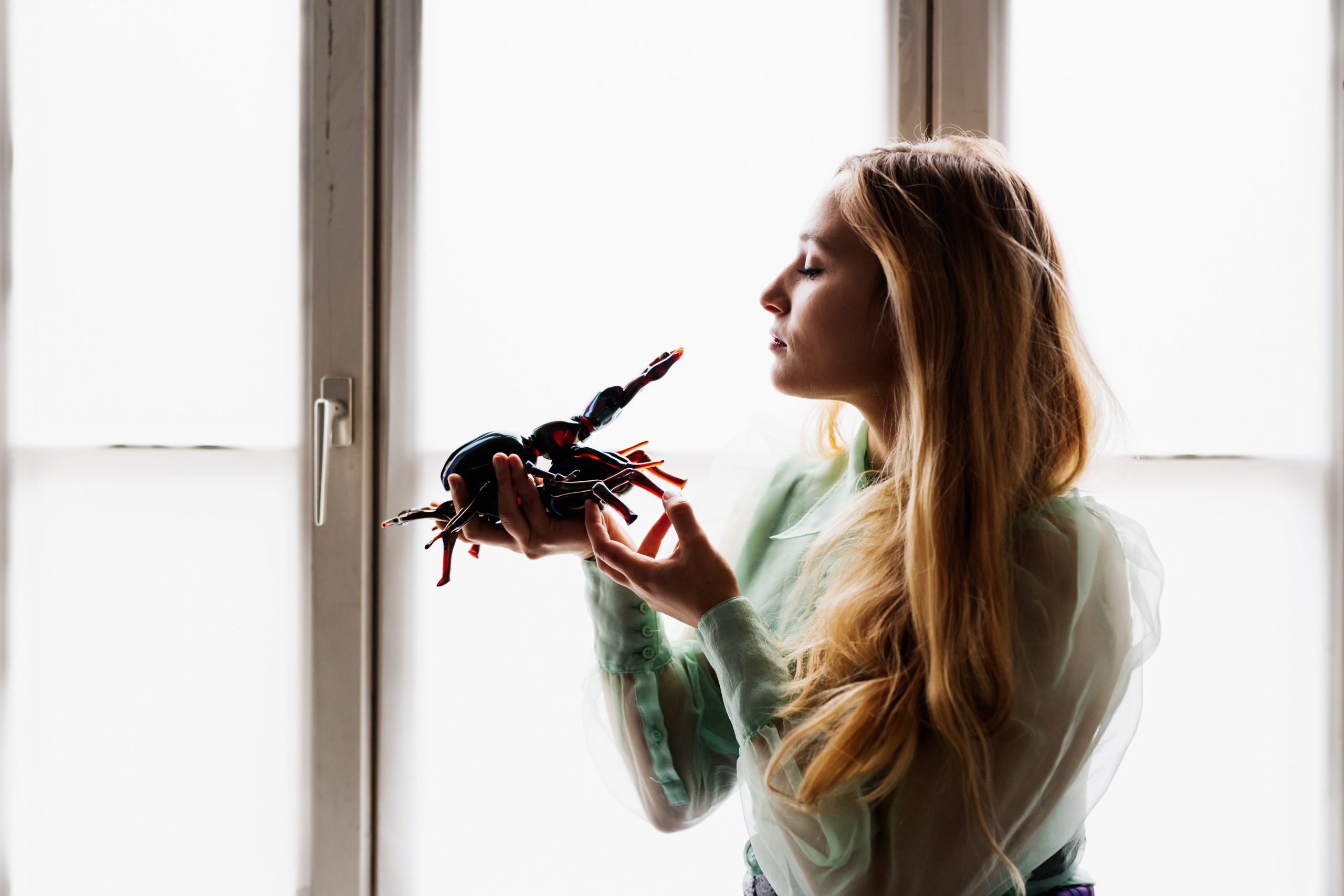
Marlene Bart with Stag Beetle Love Affair, 2020 – Photo credit Gideon Rothmann
Definitely, and those expectations we bring to the natural world, the same thing happens with glass, people come with an expectation of what it is and then discover all this untapped potential.
I really loved the effect of the iridescence. In my printmaking I often don’t print on white paper, but on material that reflect, or on paper with a metallic surface, I also did plenty of holographic works. So it presented a really nice connection to my two dimensional work. It would also be nice to connect some objects in the same way, so with the claw I also made it like a cage to maybe then put some real taxidermy underneath.
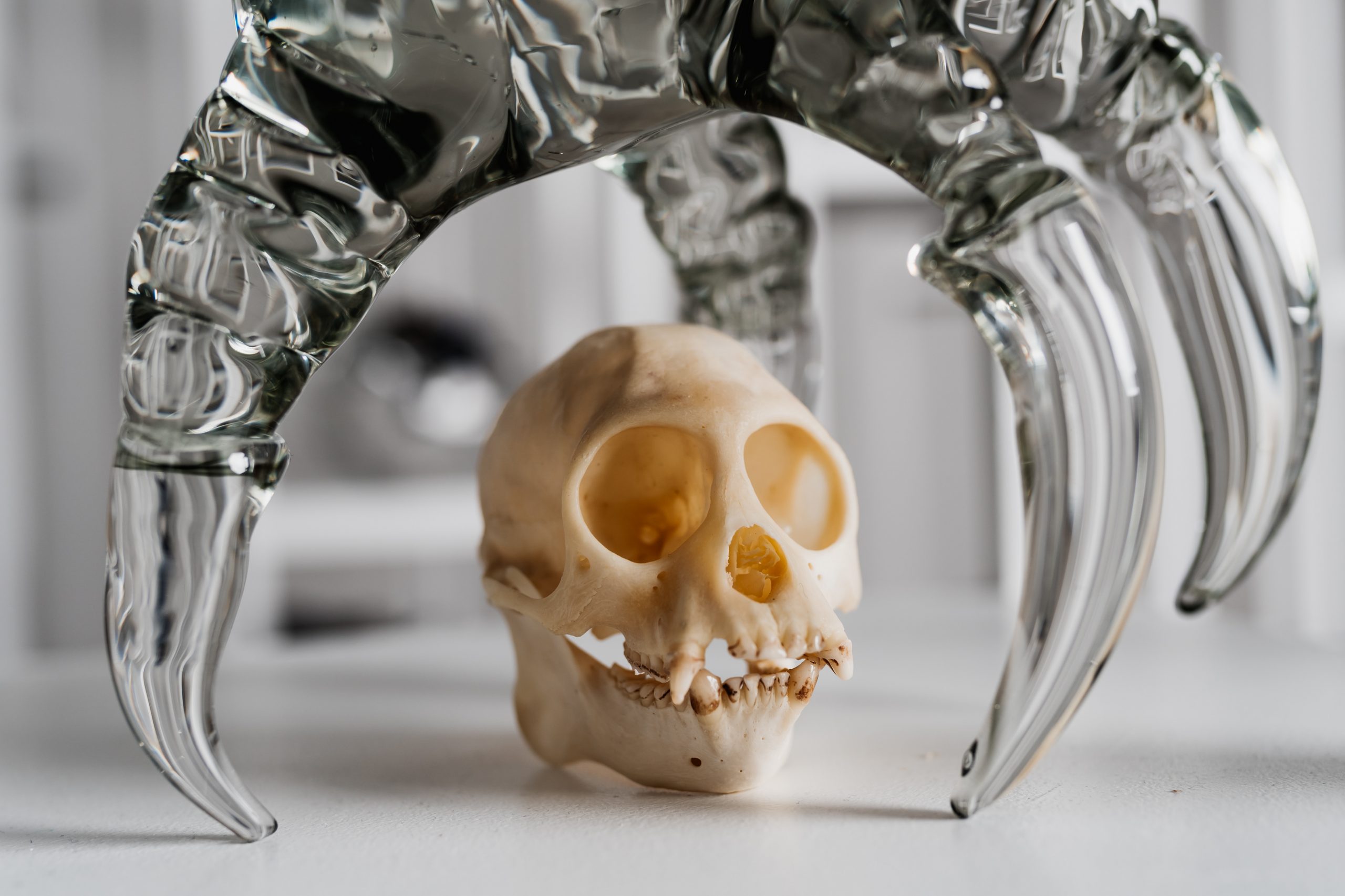
Marlene Bart, Cage, 2020 – Photo credit Gideon Rothmann
Yes combinations and contrasts can be so powerful.
Glass is a hard material to work with, because we’ve seen it in so many things, or we just think about chandeliers and vases for flowers and champagne glasses, and how can you deal with that as an artist? Because sometimes we want to do something edgy or absurd.
Before glass you worked with plastic, but you were able to do that by yourself so it must have been a more intimate process…
Yes exactly. I like to do these things myself, but with glass it was quite clear that I wasn’t able to realise it or I would need ages to learn. So it was an interesting experience to give away the craft. Then again because I felt that someone else was doing the object I had to think even more about my concept. So I didn’t feel like I was losing control or losing power, I felt more like the power shifted to the conceptual part. You always end up thinking, is this is pretty? Is it disgusting? Does it look stupid? All these thoughts come up, then you have to see how to deal with it and think about who’s going to interact with the object in the end. This stuff should never influence your work, but everyone thinks about it. It’s always important to step back and think about your artistic approach. You can’t always make pretty things. Sometimes you have to kill your darlings.
It’s true! It’s nice that you had time to experiment too, how was that? Did you have any expectations of the works in glass?
It’s never good to have too clear expectations of anything. So even if I produce my own works, I don’t know exactly how it’s going to look, so I’m not a perfectionist in that sense. I like to be surprised by my work. It was interesting to be surprised by what the maestro could do, but after the first object, I would get an idea about how the next one could look. There are so many interesting technical aspects about glass that I don’t know that he knows so he could come up with the solutions. So it was good, I hope he felt involved. I don’t like to use people as a technician. It’s really about communication
Do you feel you’ve learned a lot about glass?
Yes, so much. I still find it so crazy. I watched the glass master the whole time. At some points, I thought, could I do something else? But then I just wanted to keep watching, because I felt every time something new would happen.
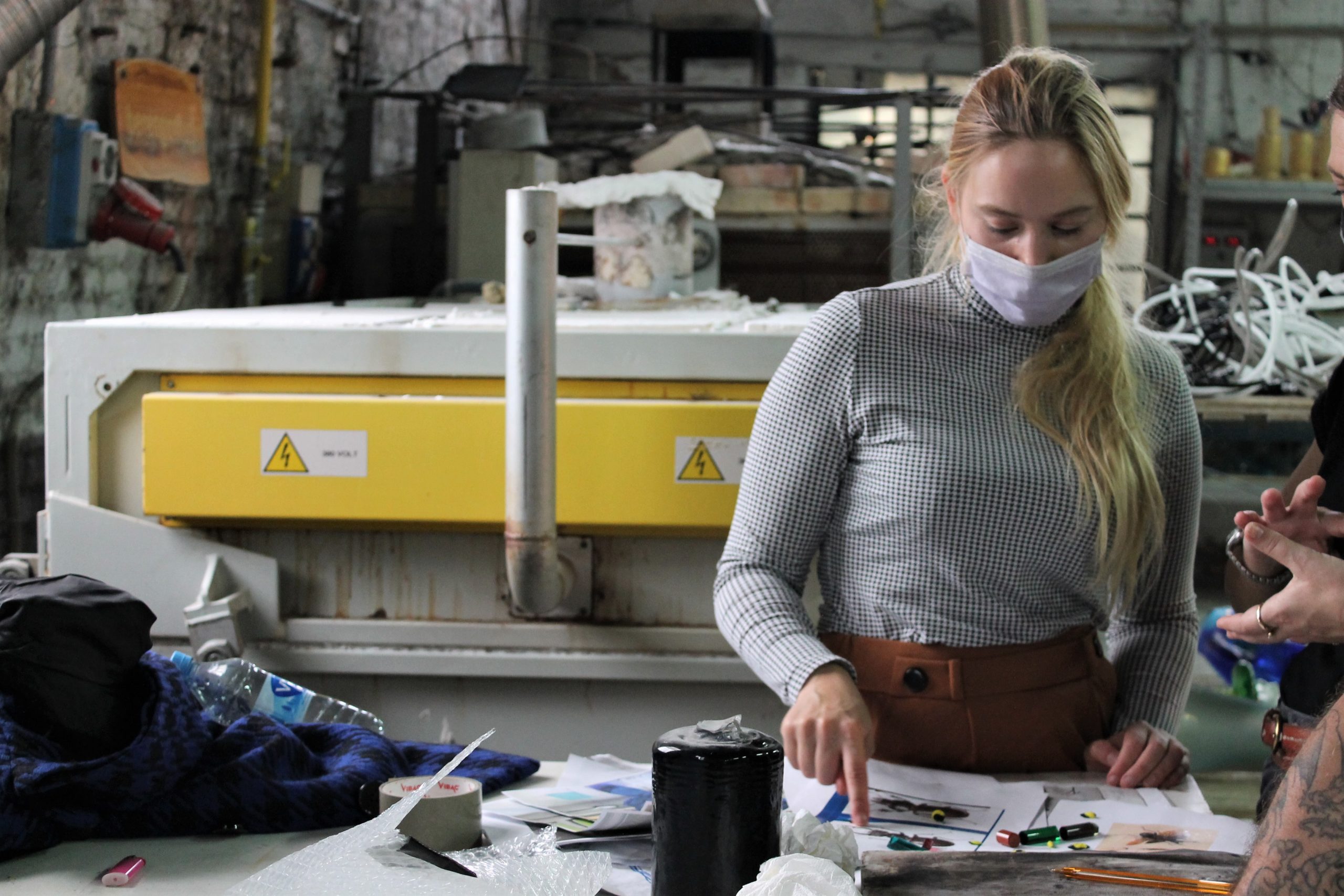
Marlene Bart at the furnace, 2020 – Courtesy Berengo Studio
There’s definitely been a progression. How do you feel your ideas have developed? Do you think they’ve adapted to the material or they’re reacting against it?
I think both. I never expected that I could do so many works. I have a lot of strange ideas, but then at some point, I had this idea of coming here and doing one object – then we did one object in half an hour! It was like ‘we have one hour left, what do you want to do?’ sometimes this kind of pressure can be difficult, but I actually liked it, because I was able to play and a lot of crazy ideas I’d always had could finally leave my head and be realised. Very often objects are also a starting point for other works and that’s interesting. It would be fascinating to use objects to create some new prints, which could be on glass or another reflecting material. I already printed on glass, so this is interesting as again it’s connected with something I did previously, I like this synthesis. Thinking about taxidermy, going back to the real natural object, asking myself what does it have to do with that? So this is just an imaginary thing. I think you have to be careful if you focus on nature as an artist not to use nature just for stuff that looks nice, or where you think, ‘oh, we’re going to do a snail now because snails are cute’ or because people like snails. I think a lot of people like these images of the snails that are glued together, but they actually don’t know what’s happening. So they’re making love, it’s biological reproduction. It’s interesting then to take a closer look at what is actually happening there, why are they doing this? How many snails of this species still exist? So maybe trying to have a sharper view on what is actually happening with nature? It’s not just about a pure critique, but we should be more aware of what’s happening around us. I think it’s interesting and important to shift perspectives. I once did an interview with a taxidermist, and I asked him, do you think taxidermists are artists? He said no he doesn’t think it’s art, it’s a craft for him. And he said, and this I found really interesting, that nature is always the border for them, because they can’t look abstract.
So much of your work stems from nature and forms that resist abstraction, yet you’re also building on these images by bringing a different lens to nature. Take the Marten skull, the real one is small but in glass you’ve made it giant, it could be a Dinosaur. There’s that element of the uncanny where you feel you’ve seen it before, but you don’t quite know where.
Yes, scientists call it the chain of representations. It’s a progression, it’s similar to what happens in artistic processes. So with the skull that I had from the Marten, I reconstructed it by myself. So it was roadkill, but I did the taxidermy. I glued all the teeth inside, and decided how it was going to come together, because it had a hole in its head. So it was interesting to see it that big, and also how the glass was much thicker. So the Marten became massive and strong, but the bone it came from was so fragile and small, the finished piece still seemed to carry the memory of the roadkill. With Dinosaur’s it’s funny because it’s the kind of species we basically know nothing about, I mean, most of what we think to know are imaginations or scientific animations. What I really like is this link between art and science or imagination and objectivity.
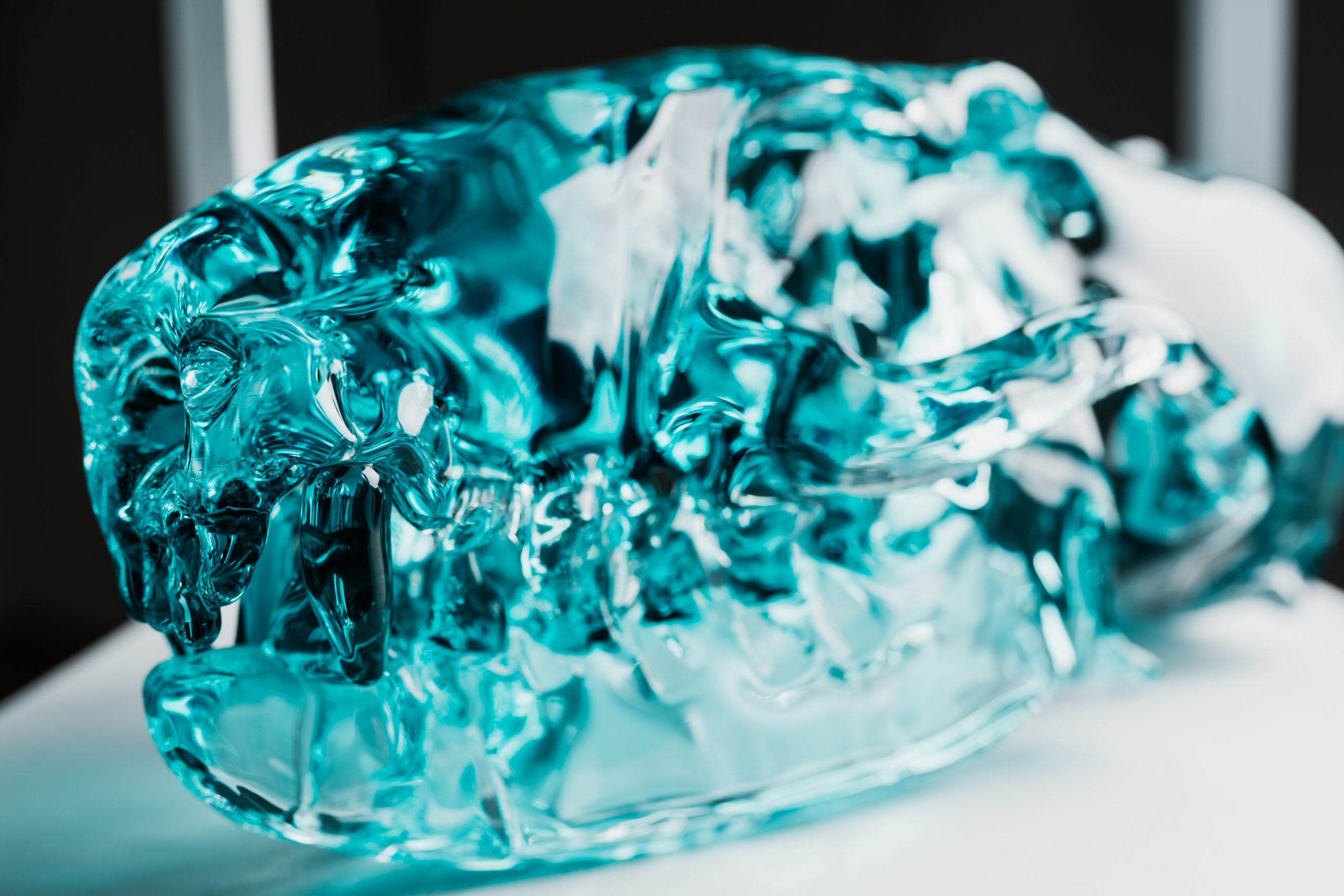
Marlene Bart, Mammaliasaurus 2.0., 2020 – Photo credit Gideon Rothmann
Yes, that gap between art and science is a contemporary construction, they have similar roots.
There’s a great book by Lorraine Daston and Peter Galison called Objectivity, and they focus on this history of scientific objectivity. So how the observation of nature changed, at one point they speak about scientists who work with artists, and how some scientists didn’t like being so dependent on the artist because they wanted to do it by themselves. In the end the artist was the one who decided how the image of the discovery was going to look, so photography became very important because it made scientists more autonomous. Artists began distancing themselves from the idea of pure representation. So artists start focusing on things that you can’t see, in surrealism you see how they are interested in dreams and psychoses. So it’s much more about the imaginary power of the other.
Yes it’s less concrete, it’s about feelings and moods…
Yes, and I feel nowadays we also still have a very weird idea of the artist as a genius who should always have these great ideas. I don’t know, that’s a very strange image of the artist being a person who’s kissed by an idea, not doing any research, not reading any books.
But also being isolated, whereas in reality so much of creativity and creative process is about collaboration and community…
Absolutely, today artists are much more like researchers, it’s more natural, there’s an understanding of how important research is for artistic ideas. I think it’s impossible not to do artistic research.
Definitely. For these artworks when you’re visualizing them how do you see the works playing with the space?
It’s always a question of the conversation with the other objects. It would be super interesting to do some kind of intervention and to hide them, or make them part of a spatial taboo, this is something that really interests me. But what I also really enjoy is creating a new architecture for the objects. Once I made these shelves that were mirrored in the middle, so you didn’t have a visual hierarchy, or at least not a strong hierarchy.
So you can create environments for each artwork, smaller worlds within the world of the museum.
Yes and if shelves or cabinets start crossing, if they have connections between them, like little pillars or lines of material, it adds another dimension. So you can change your perspective, and then you would see one object with a certain object and then with another object depending on your position.
One last question. What was your favourite part of the process working in the studio and what was the most challenging?
The most fascinating part was trying to understand when the material is flexible and when it gets hard, because the border seems to be so thin. So one moment it’s so flexible and the colour is also changing and he can change the position and then the next moment it’s already hard, so I was thinking a lot about the degrees and how hot it was in that moment! I think the most challenging was when I had various ideas where parts of the animals (like the snakes and the spiders) were sitting half in and half out of the glass. I told the maestro ‘okay if it’s not possible the glass could be empty’, so then he did an empty glass just for the snakes but then he had to start over because the snakes became so long he had to do the glass around them. In the end it was nicer because it really looked as if there was some liquid inside. It was hard because at first it seemed like it would be impossible to do. I was worried it wouldn’t turn out how I thought it would be, but then challenges are interesting and necessary. It took a few experiments but it came out in the end.
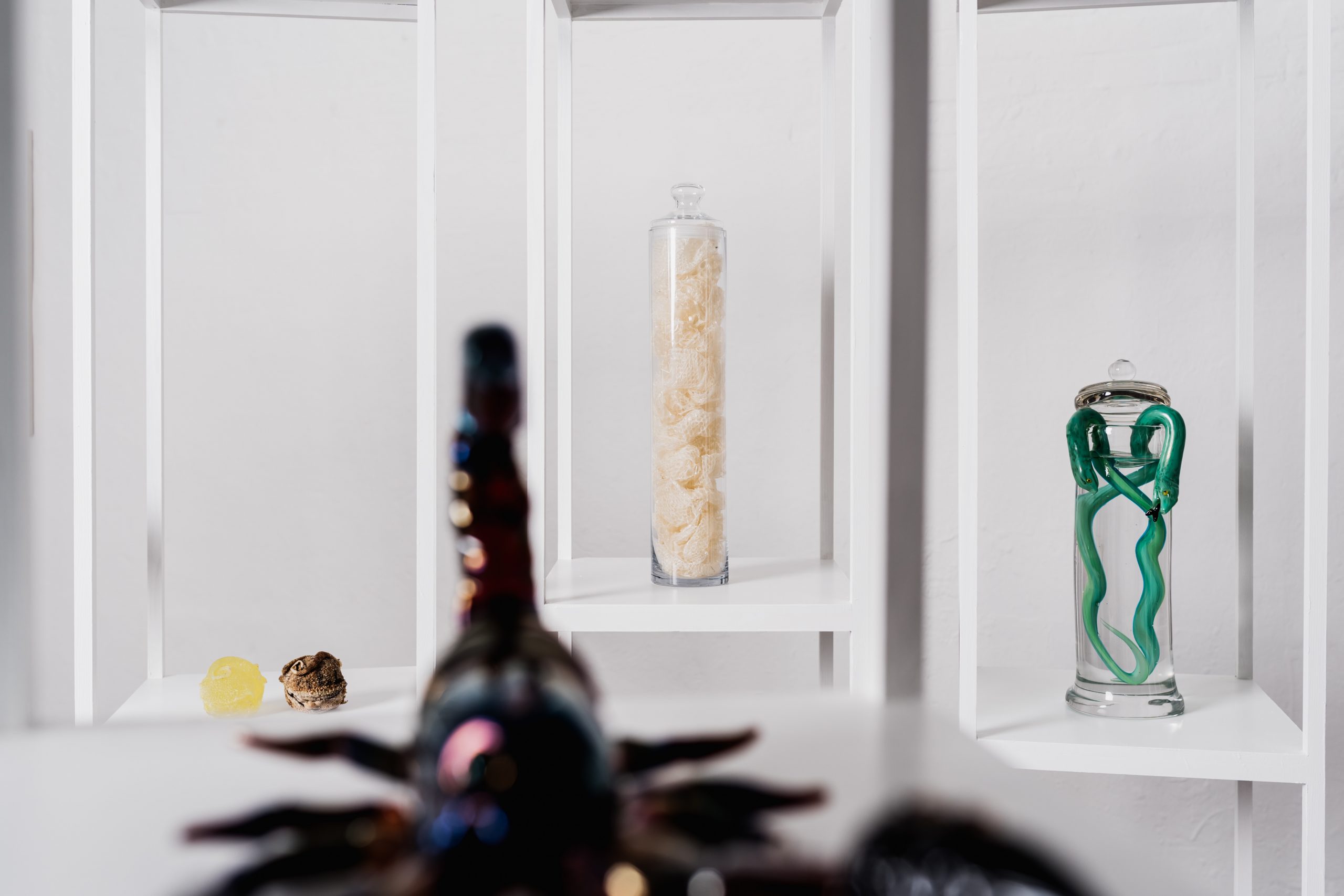
Taxa & Theater of Memory, Exhibition View, 2021, Allgemeiner Konsumverein, Braunschweig – Photo credit Gideon Rothmann


Recent Comments